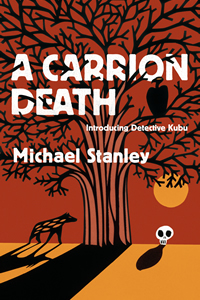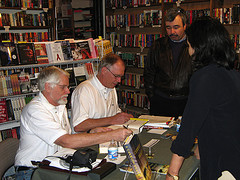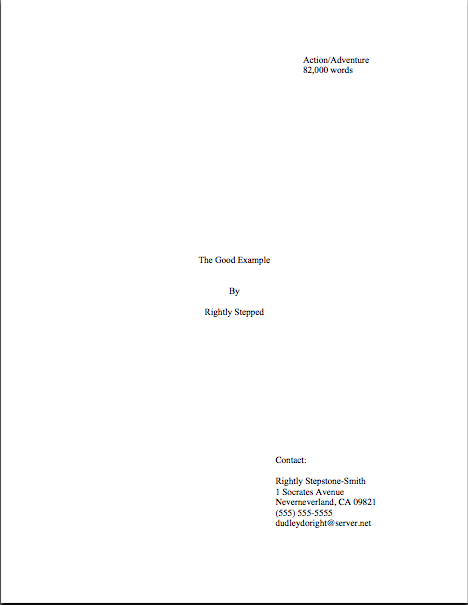
Had I mentioned lately that I’m proud of you, readers?
Seriously, I am, especially those of you who have mustered up the courage to pitch, query, and/or submit recently. It takes genuine bravery to put yourself and your work out there; I don’t think the writing community gives aspiring writers enough credit for that.
You’ve chosen a hard path, after all, and are approaching it rationally; it would be easier, let’s face it, just to sit around dreaming about how nice it would be to be a published author. But few of the authors whose books currently grace the shelves got them there by dreaming alone — most put in years, if not decades, perfecting their craft and learning how to market their work.
As you continue to do, I hope. So I’ll say it again: I’m proud of you.
In an effort to become even prouder of those of you who do not have easy access to face-to-face pitching opportunities and — dare I say it? — the vast majority of you who do not have the resources readily available to attend a first-rate writers’ conference, I am going to show you how to apply those lessons we learned in constructing a pitch to crafting a pleasing query letter. I hope you’ll pardon me, though, if I put that worthy topic on hold for a day to go over how to put together a submission packet.
I know, I know: I’ve been lavishing a lot of attention on pitching lately, and I freely admit that the timing on this week’s series is all about trying to help those pitching this conference season. However, since all of you, I hope, will be facing the joyous-but-stressful prospect of responding to a request for pages at some point, whether you get there by querying or pitching, I feel justified in dealing with this all-important topic now.
Another reason to leap right into submission packets: for those of you who aren’t already aware of it, much of the NYC-based publishing industry goes on vacation between mid-August and Labor Day — and yes, that includes the staff of the average agency. So if you’re pitching or querying this summer (or already have), you’re better off waiting until after Labor Day.
Actually, as I mentioned a couple of weeks ago, you might want to hold off for a week of so after that. Why? Well, do the math: if the average agency receives somewhere in the neighborhood of 800-1200 queries per week, and most of the staff has been out of the office for a good three weeks, how many square inches of Millicent the agency screener’s desk are going to visible on the morning after Labor Day?
Got that answer firmly in mind? Okay, if you were Millicent and had to plow through all of those stacks of extra letters (and virtual stacks of e-mails) before you could even begin the current week’s avalanche, would you (a) sit down to read in a joyous, lighthearted mood, refreshed from your time away, or (b) be looking even more fiercely than usual for the most miniscule excuse to reject the query or submission in front of you, simply to have one less piece of paper on your desk?
Give her a week or so to get that urge out of her system. Trust me on this one.
So if you haven’t had the opportunity to read your pages for submission IN HARD COPY, IN ITS ENTIRETY, and OUT LOUD, might want to take advantage of the last few days of the annual August break to do that. Ditto if you have yet to get good feedback from first readers outside of your circle of family and close friends (who tend to have a hard time giving unbiased feedback, no matter how gifted they are as readers; for more on the hows and whys of selecting good first readers, please see the GETTING GOOD FEEDBACK category at right).
Even as I was typing those last two paragraphs, however, I could see that mad light in some recent pitchers’ eyes. It happens in the wake of every large writers’ conference in North America: scads and scads of aspiring writers suddenly become speed-obsessed, determined not to sleep, eat, or take your multivitamins until they get those requested materials out the door.
Last week, I brought up several reasons that an aspiring writer might not want to give in to that common urge…but wait; what is that strange whirling object floating in the air before you? You are getting sleepy, I tell you. Very, very sleepy…
Did it work? Have those of you who harbor the belief that you absolutely must submit before the requesting agent forgets on which side you part your hair abruptly woken up, exclaiming, “Wait a minute — that agent heard dozens of pitches at the conference, and she appeared to be taking fairly thorough notes. Would it not thus make significantly more sense to invest a couple of weeks in polishing and revision, since the request for materials is a one-shot opportunity? Might I not, for instance, indulge in another round of spell-checking?”
I thought not. Worth a try, though, because the single best piece of advice those of you who have pitched or queried successfully recently could get right now is RELAX.
Actually, it’s some of the best advice you could take at any point of the marketing process: you are relaxing, I tell you, RELAXING in the face of your upcoming pitching appointment…your only goal is to get these people to ask to see your work…you are buttonholing agents in at conference events and successfully giving your hallway pitch…you are calmly going through your 2-minute pitch to an agent who is delighted to hear it…your only goal is to get these people to ask to see your work, and you are thrilled when they do…
Did it work that time?
No? Well, for the sake of argument, let’s assume for the moment that the mantras I’ve been chanting at you for the last few weeks have worked, and an agent or editor has asked to see the first chapter, the first 50 pages, or even the entirety of your manuscript.
What do you do next?
In the first place, you should send your submissions simultaneously to everyone who asked for them.
Stop looking at me with those eyes of glowing reproach; it honestly is in your best interest to have more than one agent interested in your work. Yet most successful pitchers do not think of the luxury of being able to choose between offers (awfully nice, as I can tell you from experience), or the advantage of being able to mention in their cover letters to each that others are also considering the pages (nothing adds to a manuscript’s attractiveness like the news that other agents also believe it is marketable), or even the undeniable strategic pluses of being in a position to e-mail a reading agent the news that another agent has already made an offer (you wouldn’t believe how much that little bulletin can speed up the reading process).
What do they do instead? Typically, pick the agent they liked best personally (almost invariably the one who was nicest during the pitch meeting) and submit the requested pages to her only. Then they sit around and wait for her to get back to them before submitting or querying anybody else.
This strategy made a little more sense back when turnaround times were shorter — and a lot more sense back in the days when agents always sent a rejection letter. Now, a writer playing favorites might not hear back on a submission for three or four months, if at all.
So why do so many pitchers maximize the probability of living in limbo for months on end by playing favorites, essentially granting the friendliest agent an exclusive he did not request? Perversely, it’s often because they believe that such an approach will save them time.
“If I already know I like Agent Q best,” they reason, “why should I go to the trouble of multiple submission?”
Because a writer’s time is valuable, that’s why. If you honestly feel that your manuscript is ready to market now, why waste months by submitting only one at a time, if you are dealing with agents who do not request exclusives? (A question even better worth asking if you are querying one by one, by the way. Unless an agency has a formal policy forbidding simultaneous queries — which only a tiny minority does — most agents just assume that a savvy writer is querying broadly.)
Another popular reason for embracing the wildly inefficient submit-wait-submit-wait strategy is the aftereffect of the phenomena we saw in action in last weekend’s little dramas: many, many pitchers mistake an agent’s professional friendliness for the beginning of a long-term friendship.
“But I promised Agent Y that I would send her my pages,” these starry-eyed souls protest. “She’ll be hurt if she finds out I also sent requested materials to Agent Z. I don’t want to mess up our relationship.”
I hate to burst anyone’s bubble, but if the only contact a pitcher had with an agent or editor was in a pitch meeting or hallway exchange, there isn’t a relationship yet. It was just a nice conversation about your work.
Treat it like a professional opportunity, not like a junior high school crush. Don’t sit by the phone, willing that agent to call.
Stop rolling your eyes at me, romantics. Your heart may tell you to give that dreamy agent who was so nice to you an unrequested exclusive, but believe me, your brain should be telling you to play the field.
Don’t tell me that love is blind. Wear your glasses, for heaven’s sake.
Second, you should send precisely what each agent asked you to send.
The first 50 means just that: the first 50 pages in standard format. Under no circumstances should you round up or down, even if pp. 49 or 51 is the last of the chapter.
Yes, even if that means stopping the submission in mid-sentence. (And if you aren’t absolutely positive that your manuscript IS in standard format or if you were not aware that manuscripts are NOT formatted like published books, please run, do not walk, to the FORMATTING MANUSCRIPTS category at right. Improperly-formatted manuscripts are like a vacation in an envelope to Millicent: the second her eyes light upon one, she knows that she may be excused from reading it. Coffee break!)
Why follow the rules to the letter? Because part of what you’re demonstrating with the submission packet is that you are a writer who can follow directions — a rarer bird than you might think. Many, if not most aspiring writers believe, wrongly, that if their writing is good enough, no other considerations matter.
Here I go, bursting pretty bubbles again: poppycock. If an aspiring writer demonstrates at the submission stage that he isn’t very good at following directions, can you blame an agent for concluding that that he might later ignore prevailing formatting expectations when they were preparing to submit to an editor, or that he would kick and scream about incorporating editorial suggestions?
That, in short, he would be a pain to represent, and that he might be better off signing another writer?
Believe me, an agent who decides to sign a writer will be issuing a LOT of directions between that initial handshake and sending out that book or proposal to editors. A writer who cannot follow basic packaging directions (such as “Send me the first 50 pages, please.”) is inherently more time-consuming to represent. Thus, tractability and attention to detail are rather desirable attributes in a potential client who might reasonably be expected to meet sudden deadlines or make surprise revisions down the line.
Which first impression would you rather your submission convey?
Remember what I was saying over the weekend about the desirability of impressing the agent of your dreams with how easy you would be to work with down the line? Well, this is your chance to prove it: no slipping in an extra five pages because there’s nifty writing in it, no adding a videotape of you accepting the Congressional Medal of Honor, no cookies or crisp $20 bills as bribes.
Need I say that I know writers who have done all these things, and now know better?
If you’re asked for a specific number of pages, don’t count the title page as one of them or number it — but no matter how long an excerpt you have been asked to send, DO include a title page. (If you don’t know how to format a professional title page, or even that there is a professional format for one, please wend your way to the YOUR TITLE PAGE category at right.)
If asked for a synopsis, send one; do not enclose one otherwise. Ditto for an author bio (don’t worry; I’ll be talking about how to build one soon; if you’re in a hurry, check out the AUTHOR BIO category on the list at right), table of contents (unless you’ve been asked to submit a book proposal), illustrations, letters of recommendation from your favorite writing teacher, and/or the aforementioned cookies.
Just send what you’ve been asked to send: no more, no less.
With two exceptions: unless an agency SPECIFICALLY states otherwise, you should include a SASE, industry-speak for a stamped (not metered), self-addressed envelope for the manuscript’s safe return, and you should include a cover letter.
Why the cover letter? Well, in the first place, render it as easy as humanly possible to contact you — the last thing you want is to make it hard for them to ask for more pages, right? But also, you should do it for the same good, practical reason that I’m going to advise you to write
(Conference name) — REQUESTED MATERIALS
in 3-inch letters on the outside of the envelope: so your work doesn’t end up languishing in the slush pile of unsolicited manuscripts (which are, incidentally, almost invariably rejected).
Why mark up the outside of your pretty envelope? Well, agents and editors hear a LOT of pitches in the course of the average conference; no matter how terrific your book is, it’s just not reasonable to expect them to remember yours weeks after the fact (which it almost certainly will be, by the time they get around to reading it) simply by its title and your name.
Thus, it is in your best interest to remind them that they did, indeed, ask to see your manuscript.
Be subtle about the reminder — no need to state outright that you are worried that they’ve confused you with the other 150 people they met that day — but it is a good idea to provide some context. Simply inform the agent or editor him/her where you met and that s/he asked to see what you’re sending. As in,
Dear Mr. White,
I very much enjoyed our meeting at the recent Conference X. Thank you for requesting my fantasy novel, WHAT I DID TO SAVE THE PLANET.
I enclose a SASE for your convenience, and look forward to hearing from you soon. I may be reached at the address and phone number below, or via email at…
Regards,
A. Writer
That’s it. No need to recap your plot or re-pitch your concept. Simple, clean, businesslike.
But do NOT, I beg you, present it in block-indented business format, as the rigors of blog format have forced me to do above — indent your paragraphs.
Why? Long-time members of the Author! Author! community, chant it with me now: many folks in the industry regard business format as only marginally literate, at best.
Don’t stand there, arguing that since this is a business transaction, business format is appropriate. Trust me, they don’t care what you do in the multi-million dollar factory you run: indent those paragraphs whenever you are dealing with anyone in publishing.
Oh, and if other agents or editors requested pages, mention that others are also looking at it. No need to be specific. This is considered good manners, and often gets your submission read a bit faster.
The other reason that mentioning where you met is a good idea is — and I tremble to tell you this, but it does happen — there are some unscrupulous souls who, aware that pitch fatigue may well cause memory blurring, send submissions that they CLAIM are requested, but in fact were not.
“Oh, like he’s going to remember ANY pitcher’s name,” these ruthless climbers scoff, stuffing first chapters into the envelopes of everyone who attended a particular conference.
Such scoffers occasionally receive a comeuppance redolent with poetic justice: VERY frequently, the roster of agents and editors scheduled to attend a particular conference changes at the last minute. How well received do you think a, “I enjoyed our conversation at last weekend’s Conference That Shall Not Be Named,” letter goes over with an agent who missed a plane and didn’t show up at that particular conference?
Tee hee. Serves the sender right.
Most importantly for the sake of your blood pressure, though, bear in mind that you do NOT need to drop everything and mail off requested materials within hours of a conference’s end. The standard writers’ conference wisdom advises getting it out within three weeks of the conference, but actually, that’s not necessary.
Especially this time of year.
And no, an agent or editor’s perceived friendliness during the pitching session should NOT be regarded as a legitimate reason to rush a submission out the door willy-nilly. Out come the hymnals again: a nice conversation with an agent or editor at a conference is just a nice conversation at a conference, not a blood pact.
Nothing has yet been promised — and it can’t have been. As I have mentioned several dozen times throughout my recent Pitching 101 series, no agent is going to sign you on a pitch alone; no matter how good your book concept is, they are going to want to see actual pages before committing.
Why? I refer you to that crusty old industry truism: “It all depends upon the writing.”
By the same token, you are not bound to honor the request for materials instantaneously. And no, the fact that you said you would send it the moment you got home from the conference does NOT mean that you should send it off without proofing and performing any necessary revisions; unless they asked for an exclusive, they do not expect you to send it within a day or two, or to overnight it.
Besides, it is very much to your advantage that they see your work at its absolute best, after all, not as our work tends to be before a hard-copy proofing.
Long-time readers, chant it with me now: take the time to read EVERY page you intend to submit to ANYONE in the industry in hard copy, out loud, every time.
There is no better way to weed out the mistakes that will strike you a week later as boneheaded (for real-life samples of these, see the archived Let’s Talk About This on the subject), and the extra couple of weeks fixing any problems might take will not harm your chances one iota.
I know that I have been asking you to trust me quite a bit throughout this post, but please do it one more time: agents and editors meet too many writers at conferences to sit around thinking, “Darn it, where is that Jane Doe’s manuscript? I asked for it two weeks ago! Well, I guess I’m just going to reject it now, sight unseen.”
A common writers’ negative fantasy, but it just doesn’t happen. These people are simply too busy for that. If you wait 6 months to send it, they may wonder a little, but 6 days or 6 weeks? Please.
So unless you already have the manuscript in apple-pie order (which includes having read it — take a deep breath now, so you can say it along with me — in its ENTIRETY, IN HARD COPY, and ALOUD), it’s worth your while to take the time for a final polish.
You want your book to be pretty for its big date, right?
And yes, Virginia, I do in fact plan to go over how to pull together a submission packet that just bellows, “This writer has done her homework! How refreshing!” However, I had promised some weeks ago to take all of you on a breathless little joyride through the ins and outs of producing a stellar query letter before the end of Labor Day week, so I shall be devoting the rest of this week to that. I shall return to submission packets immediately thereafter, though.
Hmm, what could a writer with a request for materials burning a hole in her computer do in the meantime? You are relaxing about getting those requested materials out the door, I tell you…relaxing…
Keep up the good work!









 PS: lovers of fluffy bunnies and winsome chicks should make sure to visit Author! Author this weekend, when we will be visited by a guest blogger I’ve been hoping for a long time would join us here. As some of you may have begun to suspect over the past few days, I’m pretty excited about the prospect.
PS: lovers of fluffy bunnies and winsome chicks should make sure to visit Author! Author this weekend, when we will be visited by a guest blogger I’ve been hoping for a long time would join us here. As some of you may have begun to suspect over the past few days, I’m pretty excited about the prospect.





























